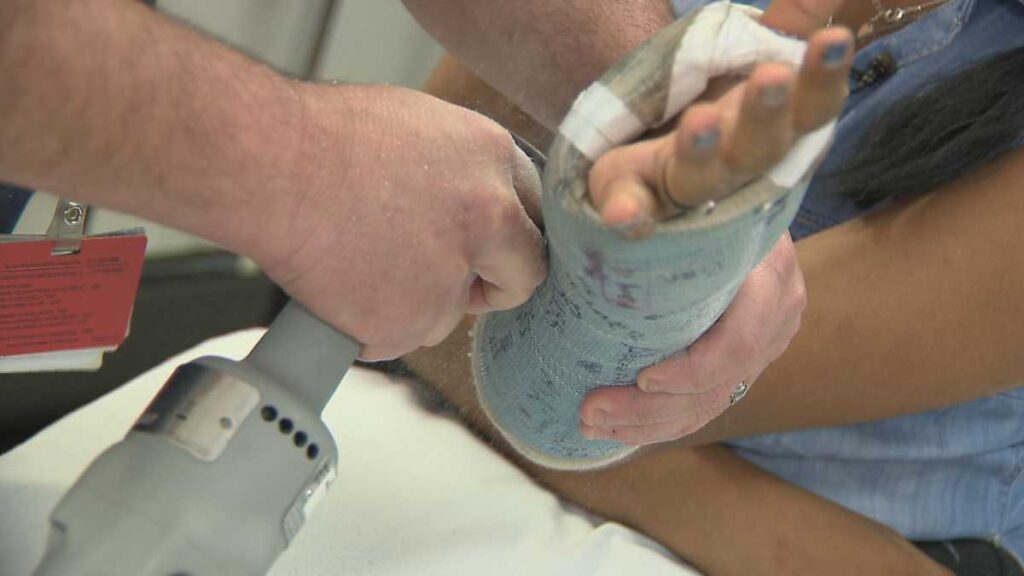A cast saw is a medical device used to remove casts without harming the patient. It works by using an oscillating blade with fine teeth to cut through the cast material through rapid back-and-forth motion.
Furthermore, the saw generates friction and vibration to weaken and break the cast safely. Safety features, like a blade guard, prevent injury to the patient, and proper technique is essential.
Different cast materials may require specific saw types or cutting techniques. Cast saws are crucial tools in orthopedics for safe cast removal and patient care.
How does the cast saw blade function?
The oscillating blade in a cast saw is a crucial component responsible for cutting through the cast material. It is a flat, narrow, and serrated blade.
Furthermore, this blade has a distinctive shape, often resembling a curved, rectangular tube, with the serrations running along its length.
In addition, its design allows for rapid, controlled oscillation, typically at a high frequency, which is essential for effective cutting.
Explanation of the Blade’s Material and Design:
Cast saw blades are typically made of high-quality materials such as stainless steel or carbide. These materials are chosen for their durability and resistance to corrosion.
Furthermore, the blade’s serrated edge features fine teeth that are essential for cutting through cast materials like plaster or fiberglass.
The blade design minimizes the risk of causing harm to the patient’s skin or soft tissues while efficiently cutting through the cast.
Overview of Safety Features, Including the Blade Guard:
Cast saws incorporate several safety features to protect the patient during cast removal. The most prominent safety feature is the blade guard, which is a protective housing that surrounds the oscillating blade. It acts as a barrier between the blade and the patient’s skin.
Moreover, the blade guard ensures that the blade cannot come into direct contact with the patient, preventing cuts or abrasions.
In addition to the blade guard, cast saws often have an automatic shutoff mechanism that stops the blade’s oscillation if excessive pressure is applied, further reducing the risk of injury.
Some models also include vacuum systems to remove cast dust and debris, enhancing visibility during the removal process and reducing the risk of respiratory irritation.
How does the cast saw blade safely cut through casts?

The oscillating blade in a cast saw moves in a back-and-forth motion, similar to a pendulum or a sawing motion.
This oscillation is achieved through the use of a motor, typically housed within the handle of the cast saw, which generates a rapid reciprocating movement in the blade.
Moreover, the oscillation of the blade is precise and controlled, allowing for smooth and continuous cutting through the cast material.
This controlled oscillation is essential in preventing the blade from biting into the patient’s skin or tissues, ensuring safety during cast removal.
Role of Friction and Vibration in the Cutting Process
When the oscillating blade contacts the cast material, it generates friction and vibration at the point of contact.
The friction and vibration work together to weaken the cast material, gradually breaking it apart.
Friction contributes to the heating of the blade, which can help reduce the risk of overheating and discomfort for the patient during the cutting process.
Vibration helps dislodge small pieces of the cast material, making it easier for the blade to progress through the cast without undue resistance.
Together, friction and vibration allow for efficient and controlled cast removal while minimizing the risk of injury.
Importance of Rapid Back-and-Forth Motion
The rapid back-and-forth motion of the blade is a fundamental aspect of the cast saw’s effectiveness.
This motion ensures that the blade cuts through the cast material evenly and consistently.
It prevents the blade from getting stuck or caught in the cast, which could cause discomfort or injury to the patient.
The rapid oscillation also enables a smooth cutting action, reducing the time required for cast removal and minimizing patient discomfort.
Importantly, the back-and-forth motion allows for precise control by the operator, making it possible to navigate curves and contours in the cast with accuracy.
Final thought
In conclusion, a cast saw is a specialized medical tool designed to safely and efficiently remove casts while protecting patients from harm. Its key components include an oscillating blade, typically made of durable materials like stainless steel, and a protective blade guard.
The blade moves in a precise back-and-forth motion generated by a motor in the saw’s handle. This motion, along with the friction and vibration it creates, allows the blade to cut through cast materials without harming the patient’s skin or tissues. The rapid back-and-forth motion is crucial for even and controlled cutting.
